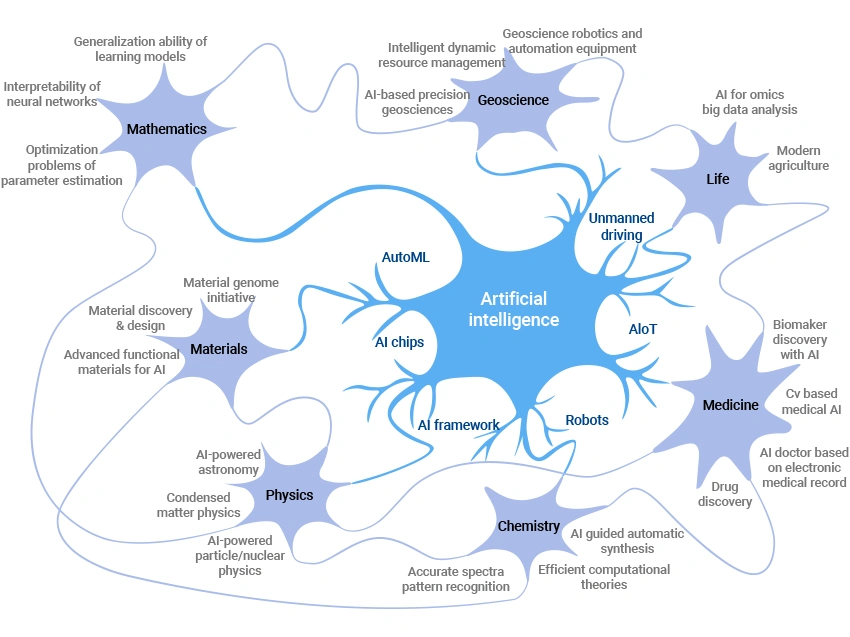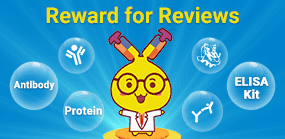The rapid evolution of artificial intelligence (AI) technologies, particularly large language models (LLMs) like ChatGPT [1,2], Claude, Gemini [3], and Deepseek, has profoundly influenced all facets of life, including biological research [4]. There are two major challenges for biological research: data explosion and efficiency bottlenecks. AI delivers disruptive solutions for this paradigm shift. AI is transforming biological research by enabling rapid data analysis, predictive modeling, experimental automation, and others.
AI doesn't replace scientists. It acts as an "intelligent microscope" that expands human cognition—from predicting protein structures to accelerating drug discovery. In 2025, Scientific AI will be more than just a tool—it’s a necessity.
This article explores more than 10 essential AI tools that are shaping the future of hypothesis generation, molecular modeling, data analysis, academic writing, and beyond.
1. AI Tools Across the Biological Research Workflow
Biological research workflow typically includes related literature search and collation, experimental scheme design, experimental data analysis, paper writing and revision, paper review, and other steps. Here are some AI tools used in these procedures.
1.1 AI Tools for Literature Review and Collation
AI tools accelerate literature mining and accurately recommend relevant studies, which helps researchers quickly locate the required data and establish knowledge networks. Common AI tools for literature review and collation include:
Scite.ai is an AI-powered literature-finding tool that analyzes academic articles using Smart Citations. It provides context-aware summaries, highlights whether cited papers support or contrast claims, and tracks relevant literature. By displaying citation contexts and evidence types, it helps researchers evaluate article credibility and streamline literature reviews.
ResearchRabbit is a scholarly publication discovery tool that uses AI to help researchers find related publications and authors, providing a unique and comprehensive set of recommendations [5]. It is designed to support visualization maps and the unstructured searching workflow. The limitations of ResearchRabbit include its steep learning curve, navigation challenges, and limitations in author disambiguation.
Consensus is an AI-based search engine designed to answer yes/no questions while providing results supported by academic consensus. It furnishes users with extracted and aggregated data from relevant papers, including citations and supplementary valuable information to aid in the selection of appropriate resources.
Semantic Scholar uses machine learning and natural language processing (NLP) to understand scientific literature semantics and assist scholars in finding relevant research. It searches and analyzes global scientific papers, providing semantic understanding and relevance assessment to help scholars locate necessary research resources quickly and accurately. The tool also offers API interfaces and developer tools for building academic applications and research tools.
Elicit is a comprehensive search engine for reliable sources, automating messy research tasks. Each extraction is supported by quotes from the underlying papers. It eliminates irrelevant papers and elicits more relevant ones. Endorsed by industry leaders such as Google and NASA, it delivers a curated collection of leading research papers, streamlining the process for researchers to gather and analyze data.
Iris.ai is an AI tool designed to enhance productivity during the literature review phase. It can automatically analyze and organize a vast quantity of academic literature to create a structured knowledge graph, thereby aiding users in quickly grasping the research context and development trends within the field.
Furthermore, it can intelligently extract and summarize key information based on the user's research requirements, cutting down on the time typically spent manually filtering and organizing literature. Iris.ai is well suited for early-stage research projects that require comprehensive literature reviews across disciplines.
EndNote is a trusted citation and reference management tool that simplifies the organization of citations and references. Its AI-driven capabilities help researchers find and manage references, ensuring proper citation formats. It can also be integrated with a word processor for seamless insertion of references. EndNote is essential for preparing academic manuscripts, dissertations, or dissertations that require careful citation management.
ChatPDF is an innovative tool built on OpenAI's ChatGPT API (GPT-3.5) to help users process and understand PDF documents more efficiently. It combines advanced natural language processing (NLP) and machine learning (ML) technologies to enable users to extract information, summarize content, or translate text by talking to a PDF file.
Scholarcy is an online tool that utilizes an AI-based algorithm to provide immediate summarization of articles, assisting in summarizing lengthy texts or articles found on websites. It automatically extracts key findings, methodologies, and references, making it easier for researchers to identify relevant studies. It can also create flashcards for quick learning and reference. It is ideal for students and researchers who manage large literature reviews or prepare for academic exams.
Scinapse is an intelligent academic search engine designed to provide researchers with accurate and relevant results. It uses AI to rank articles based on user queries, ensuring that the most influential and high-quality papers appear at the top. Scinapse is ideal for researchers conducting systematic reviews or looking for high-quality academic resources.
1.2 AI Tools in Experimental Design and Optimization
AI enhances experimental design by proposing optimized pathways based on historical data. AI tools can increase the scalability and customization of experiments and improve resource management, data analysis, and quality control. AI-driven analytics complements human insights, while automation facilitates large-scale testing. Additionally, AI streamlines literature collaboration and documentation and experimental procedures, accelerating progress in biological research.
BenchSci is an AI-based biomedical research tool designed to help scientists design and execute experiments more efficiently. BenchSci uses AI technology to get data from millions of research papers, helping researchers quickly find the right reagents and antibodies for their experiments. This not only saves time but also improves the accuracy and repeatability of the experiment. By analyzing experimental data, BenchSci can provide researchers with evidence-based recommendations to help them optimize experimental design and reduce the cost of trial and error. BenchSci's AI engine can quickly sift through relevant literature and extract key information to help researchers quickly understand the latest advances in a field.
Synthace is a browser-controlled, no-code digital platform designed for life science R&D teams to streamline end-to-end experimental workflows. It enables scientists to design, simulate, automate, and centrally manage reproducible experiments on lab equipment while structuring data/metadata automatically. By bridging the gap between experimental imagination and practical execution, it unlocks previously unachievable research capabilities and is adopted by 9 of the top 20 global life science companies.
BioAutoMATED is an end-to-end automated machine learning platform that simplifies biological sequence analysis, interpretation, and design (e.g., DNA, RNA, peptides, glycans) for life scientists [6]. It automates model selection, hyperparameter tuning, and data preprocessing while enabling advanced tasks like gene regulation prediction, peptide-drug interaction analysis, and synthetic biology component design—all without requiring extensive ML expertise.
1.3 AI Tools for Data Analysis and Automation
AI has become a transformative force in biological research, enabling scientists to automate complex tasks, analyze vast datasets, and uncover insights that were previously unattainable.
AlphaFold is the first protein structure prediction model developed by DeepMind that predicts a protein’s 3D structure from its primary amino acid sequence. It can successfully operate without using any template structures and even predict the folding patterns of previously unknown proteins.
AlphaFold2 (AF2) is the second iteration that predicts the 3D structures of proteins based on their amino acid sequences [7]. This technology uses deep learning algorithms, specifically an end-to-end deep neural network, to generate protein structures with atomic-level accuracy by leveraging information from homologous proteins and multiple sequence alignments.
AlphaFold 3, the third generation of the model, can predict not only the structure of individual proteins but also how proteins interact with other molecules, such as ligands, nucleic acids, metals, and modified residues [8].
DeepVariant is a Google Health-developed deep learning tool that uses convolutional neural networks (CNNs) to accurately detect genetic variants (single nucleotide variants (SNVs) and insertions/deletions (InDels)) from aligned sequencing data (BAM/CRAM formats). It excels in challenging genomic regions, aiding genetic disease research and personalized medicine. While highly precise, it demands significant computational resources and bioinformatics expertise for optimal use.
Laila is an AI tool developed by BioNTech based on Meta's Llama 3.1 model. It automates routine tasks in experimental biology, such as DNA analysis, visualization of experimental data, experiment monitoring, and interaction with laboratory equipment. It can significantly improve experimental efficiency and reduce manual intervention, allowing researchers to focus on more creative and strategic work.
Sapio ELaiN is a cutting-edge AI platform launched by Sapio Sciences that integrates advanced large language models to automate repetitive lab tasks and assist scientists in workflow management. Part of the Sapio Lab Informatics Platform, it seamlessly connects with Sapio LIMS, ELN, and Jarvis, streamlining data analysis, process configuration, and reporting, enabling researchers to focus on high-impact scientific discovery.
LOWE is an LLM-orchestrated workflow engine for drug discovery. It can automate workflow optimization across R&D stages, integrate multi-source data with LLM analysis, and predict molecular activity, toxicity, and pharmacokinetics using machine learning models to identify potential drug candidates. It enhances efficiency, reduces costs, and accelerates innovative drug development through data-driven decision-making.
Power BI is Microsoft's data analytics tool that transforms raw data into visual insights using AI (Copilot) and drag-and-drop reporting. It integrates with Microsoft apps, centralizes dashboards, and generates shareable reports quickly. It features AI-driven analysis and seamless ecosystem integration. However, it has limited visualization customization and is challenging for beginners.
Tableau is an AI-powered business intelligence platform for data visualization and analysis. It enables code-free dashboard creation, natural language queries, and predictive analytics. Tableau offers flexible deployment (Desktop/Cloud) and seamless integrations. It is a user-friendly drag-and-drop and CRM analytics tool, but it has occasional server latency and is high-cost for small businesses.
1.4 AI Tools for Advanced Simulations and Molecular Modeling
AI tools excel in creating predictive models for accurate biological outcome forecasting using existing datasets. They also enable simulations of complex systems (e.g., metabolic pathways, cellular processes) that are challenging to study traditionally. These AI-driven approaches provide dynamic behavioral insights under diverse conditions, advancing research beyond experimental limitations.
BioNeMo is NVIDIA's AI platform for drug discovery, providing tools like GenMol for molecular generation and DiffDock for docking predictions. It uses pre-trained models and generative AI to accelerate potential drug candidate identification and improve target selection accuracy. The platform enables large-scale training of biomolecular language models, streamlining drug development with enhanced speed and precision.
AutoDock is a molecular docking simulation tool widely used in biological research, especially in drug screening and protein-ligand interaction research. It uses the Lamarckian Genetic Algorithm to simulate molecular docking, helping researchers efficiently predict the preferred binding orientations and affinities between a small molecule and a target protein, thereby accelerating the drug discovery process.
1.5 AI Tools for Writing Assistance and Content Generation
Using the right writing and editing AI tools allows researchers to better express and exhibit their findings. These tools significantly improve the efficiency and quality of paper writing and editing, thus facilitating academic exchange.
Jenni is an AI-powered writing assistant that helps in writing, editing, reading, and citing by providing in-text citations, AI autocomplete, querying the research or generating text from the uploaded files, paraphrasing, rewriting, and more. It combines in-house AI systems with GPT4 and ChatGPT to fine-tune each user's controls and customize data to generate high-quality content.
Quillbot is an online writing and editing tool that offers various functions, including paraphrasing, plagiarism checking, AI detection, summarizing and abstract generation, and translation. It improves text clarity, fluency, and grammatical accuracy and can also avoid plagiarism. Its "Expand" feature generates content based on a few keywords or phrases to help you get more inspiration during the writing process.
Grammarly is an AI-powered writing assistant that helps users write clearly. It mainly provides advanced grammar, spelling, and punctuation checks, comprehensive style suggestions and tone analysis for different needs, and advanced plagiarism checking to enhance writing quality.
HyperWrite is an AI writing tool that uses natural language processing (NLP) and the latest AI text generation models like GPT-4 and ChatGPT to analyze your text and provide original content and suggestions based on your goals. It offers personalized suggestions and improvements by learning from users'writing styles and preferences.
Paperpal is an AI academic writing assistant trained on millions of scholarly articles. It offers language editing, structure optimization, and submission-ready checks for journal submissions. With 22+ years of expertise in science, technology, and medicine, it provides context-specific suggestions to enhance clarity and quality. Paperpal helps researchers refine academic texts efficiently while maintaining scholarly standards.
Wordvice is an AI proofreading tool ideal for enhancing academic and formal writing quality. It detects and corrects grammar, spelling, and punctuation errors. It also identifies informal/awkward terms and proposes academic alternatives. Optimized for clarity, it improves word choice, reduces redundancy, and fixes awkward phrasing.
1.6 AI Writing Detection and Plagiarism Check Tools
There is no doubt that AI has revolutionized the content creation industry. AI detection and plagiarism check tools address the academic, creative, and legal challenges to a certain extent.
Originality.ai is a full-featured content quality control tool that integrates multiple features, including AI content detector, plagiarism detector, fact checker, and readability checker, to help users enhance the quality of content and ensure its authenticity.
CopyLeaks is an AI content detector that provides granular AI content detection for ChatGPT, Gemini, Claude, Jasper 3, and T5. It is trained to understand how humans write using data from thousands of universities and enterprises worldwide. It additionally can identify human and AI mixed writing.
GPTZero is a tool designed to detect writing generated by ChatGPT. GPTZero detects AI-generated text by measuring two properties of text called "perplexity" and "burstiness."
Winston AI supports for detecting content from all major AI models, including ChatGPT, Claude, Gemini, and more. It possesses advanced AI image and deepfake detection capabilities.
1.7 Mutilfunctional AI Tools
Developed by OpenAI, ChatGPT leverages GPT-4o and o1 models for creative writing, general conversation, brainstorming ideas, translation tasks, coding, and problem-solving. The o1 version specializes in complex STEM reasoning and is used for coding, math, and technical troubleshooting. While versatile, outputs may occasionally include inaccuracies or "hallucinations." GPT-4o can analyze images, charts, and photos.
Deepseek is an open-source AI platform focused on coding, technical reasoning, and Chinese NLP. It delivers direct, concise, and informative responses efficiently but is less suitable for creative or emotional discussions. It also can be trained to perform multiple tasks such as data processing, genomic analysis, literature and knowledge management, and academic writing and communication (e.g., thesis writing, language polishing, terminology and concept interpretation).
Claude, developed by Anthropic, is strong in ethical alignment, contextual comprehension, and complex reasoning over long dialogues. It is suitable for customer service, data analysis, and formal writing, with a 200K-token context window, multilingual support, and variants (Haiku/Sonnet/Opus). It combines empathetic dialogue with content safety filters but may overexplain.
Gemini, Google's AI model, excels in multimodal tasks (text/image/video), multi-step reasoning, creativity, and coding. It integrates with the Google ecosystem and provides Deep Research for comprehensive reports, multi-draft responses, and real-time information. However, it loses conversational context more easily in long dialogues.
Grok is focused on "maximal truth-seeking" and offers the feature "Big Brain mode" for enhanced reasoning, multimodal (text/image) processing, and real-time information via X integration. It is ideal for researchers, engineers, and users prioritizing cutting-edge reasoning, speed, and scientific/technical queries. However, it may generate potential misinformation from unverified X sources and has weaker long-context memory than competitors.
Choosing the appropriate AI tool for research requires a thorough comprehension of your goals and the functionalities of the tool. Evaluate factors such as user-friendliness, availability of documentation, and the quality of support to guarantee a seamless research experience.





Comments
Leave a Comment